Canon IIF and IIS Rangefinder Cameras
A Description of these export models produced in 1953
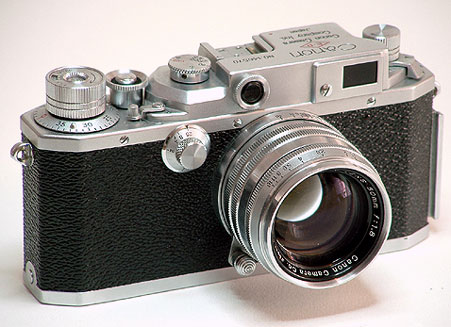
Canon IIF with the red <E•P> symbol on top
The Canon IIF of 1953
In 1953, the military Post Exchange system was in full activity, selling duty-free items to the the many USA (and perhaps Allied) military personnel in Japan and Korea. This was the period of the Korean War, and as well as Korea, there were many US military personnel still in Japan. The Canon IIF introduced in 1953 was specifically produced for export and was not sold in Japan. 4 So, nearly all sales were to the PX stores.
Canon IIF Characteristics
The Canon IIF was designed to be attractive to the Post Exchange military customer. It had a combination of attributes:
- included flash synchronization for flash bulbs via a flash rail built into the side of the camera
- more economical shutter having a 1/500 top speed.
- the 50mm f1.8 lens in a rigid chrome setting was standard on all IIF cameras.
- a combination of high quality construction with low price. Since it was not sold in Japan, Canon was able to offer a low selling price, while it incurred no commercial or distribution expenses.
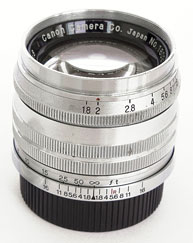
Canon 50mm f1.8 in chrome mount - standard on the Canon IIF
Use of the Canon IIF with Canon Flash Units
For the Canon IIF and Canon IIS, Canon offered a series of flash units which would slide into the side rail of the body for easy use. One of the most popular was the Canon Flash Unit Y.
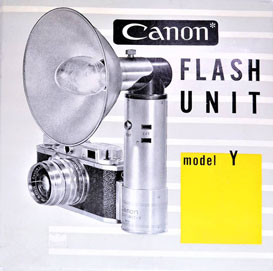
Canon Flash Unit Y
The <E•P> label
The the ⟨E•P⟩ mark indicates that the item was for "Exchange Post" sale only. This was via the US military Post Exchange duty free shops in Japan and Korea. This mark was intended to assure that the merchandise would not be sold in the domestic Japanese market. US and perhaps Allied military personnel had access to the Post Exchange stores, but Japanese nationals had neither the access nor the dollars to purchase there. Given that the Canon IIF was not sold domestically, nearly all Canon IIF cameras were later found in the USA and have the <E•P>label on the camera top. Since the symbol was prominent and just below the "Canon" name, some later incorrectly called the camera the "Canon E-P".
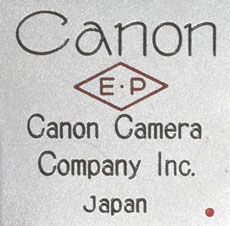
the <E•P>logo on the Canon IIF top
Sales of the Canon IIF
The Canon IIF was a well-built camera with all of the up-to-date features most photographers would look for as well as an attractive price in the PX. Consequently, its sold well: Peter Dechert estimates 11,900 units in 1953, 1954, and 1955.
Canon IIS
Recall that the very successful Canon IVSB of December 1953 was the first Canon camera to include both flash bulb and electronic strobe flash synchronization. In fact, Canon's history website 4 states that the IVSB was the world's first camera synchronized for electronic strobe flash. So, it was a small step for Canon to take its very successful Post Exchange sales Canon IIF and upgrade it to electronic strobe flash synchronization, producing the Canon IIS. This camera was introduced in early 1954. 1 Canon continued to sell the other "PX camera" - the IIF - simultaneously into the Post Exchange stores.
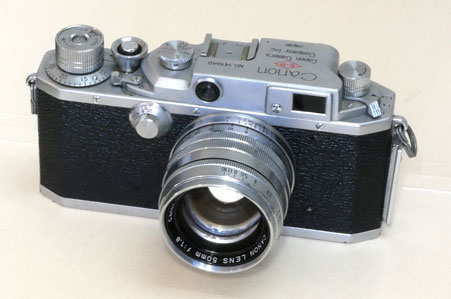
Canon IIS of 1954
with X synchronization setting on slow speed dial between 1/8 and 1/25 second
The X synchronization speed was about 1/15 second, so there was the possibility of 'ghosting' when the photograph would have both the bright strobe light illuminated image, and the lesser available light image picked up at the slow 1/15 second exposure. This would be corrected in 1955-1956 with the new shutter included in the Canon IVSB2, IIS2, and others. This later new shutter which moved the X synchronization to the fast speed dial, using a shutter speed of about 1/45 second for electronic strobe exposure. This is described in further detail in the Canon IVSB2 page of this canonrangefinder.org site.
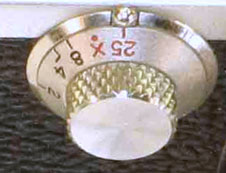
The Canon IIS slow speed dial with X synchronization position
Sales of the Canon IIS
Peter Dechert in his fine Canon Rangefinder book 1 wrote:
"...why Canon made three cameras simultaneously - IIF, IIS, and IVSB - whose specifications were so close to each other, with the IID also available as their base model, is difficult to understand today."
The Canon IIF and IIS were solid and reliable cameras, most useful in the hand of the military servicemen who purchased them. Taking these cameras back to the USA aided Canon in extablishing its identity and reputation in North America - a reputation which was reinforced by the great success of the Canon IVSB.
You can click on the links in the table below to consult other pages of the canonrangfinder.org site.
| Navigation: Click Below to Jump to Desired Subject Page | ||
|---|---|---|
| Canon Rangefinder Cameras - 1 | Canon Rangefinder Cameras - 2 | Canon Rangefinder Lenses |
| Canon S | Canon IVSB2 | Canon 19mm |
| Canon J | Canon IIS2, IID2, IIF2 | Canon 25mm |
| Canon NS | Canon VT, Canon L2 | Canon 28mm |
| Canon JS | Canon L1, L3 | Canon 35mm |
| Canon J-II | Canon VT Deluxe | Nikkor 50mm |
| Canon S-II | Canon VL, VL2 | Canon 50mm |
| Canon IIB | Canon VI-L, VI-T | Canon 85mm |
| Canon III, IIC, IV | Canon P | Canon 100mm |
| Canon IIIA, IVF, IVS | Canon 7 | Canon 135mm |
| Canon IIA, IID, IID1 | Canon 7s | Canon 200mm-1000mm |
| Canon IVSB | Minolta Rangefinders | Minolta Lenses |
| Canon IIF, IIS | Other Rangefinders | other M39 lenses |
| Go to canonrangefinder.com home page | ||
Any additions or corrections to these pages would be welcome simply by contacting this site as shown at the foot of this page .
Footnotes:
1 Dechert, Peter. Canon Rangefinder Cameras 1933-1968. Hove Collectors Books. West Sussex, United Kingdom. 1985. ISBN 0-906447-30-5.
Peter Dechert's book is the most important expert source of information regarding Canon Rangefinder Cameras.
2 Kitchingman, Peter. Canon M39 Rangefinder Lenses 1939-1971. A Collector's Guide. Published by Peter Kitchingman. Perth, Australia. 2008. ISBN 978-0-646-48144-9.
Peter Kitchingman's book is the definitive study of the more than three decades of M39 format camera lenses developed for Canon Rangefinder Cameras.
3 Nostalgic Canon Camera Book. 懐かしいキヤノン EI Publishing Co. Ltd. Tokyo, Japan. June 2003.
Peter Kitchingman's book is the definitive study of the more than three decades of M39 format camera lenses developed for Canon Rangefinder Cameras.
4 "Canon Camera Museum" history website. https://global.canon/en/c-museum/history/ published by Canon, Inc. accessed in 2019.
5 Rajner, Hans P. (author), John Wade (editor). Leica Copies. Classic Collections Publications. London, UK. ISBN 13: 9781874485056
Hans P. Rajner's book is an excellently detailed and carefully researched study of camera from around the world which used the Leica M39 lens mount and the same lens to film plane distance.
7 Dechert, Peter. Canon Single Lens Reflex Cameras 1959-1991. Historical Camera Publications. Yakima, Washington. 1992. ISBN 1-879561-04-2.
8 Tomlinson, Shawn M. The Film Photography Book. Lulu Pulbications. 2016. ISBN: 9781365263972
9 Sartorius., Ghester. Identifying Leica Lenses. Classic Camera 19. Tokyo, Japan. 2001. ISBN 4-257-12029-0
10 website http://www.nicovandijk.net/rflensmatrix.htm consulted 2019.
11 O'Reagan, Douglas M. Allied Exploitation of German Science after World War II. Johns Hopkins University Press. Baltimore, Maryland. 2019. ISBN 9781421428888
12 website www.canonrangefinder.servehttp.com consulted 2008.
13 Minolta expert Andrea Aprà has posted information on minoltarangefinders group and other groups and further detailed information by email. (thanks Andrea !)
14 website http://www.collection-appareils.fr/objectifs/ consulted 2019.
15 Small, Marc James. Non-Leitz Leica Thread-Mount Lenses. Wittig Books. Hückelhoven, Germany. 1997. ISBN 3-930359-47-2.
16 the Nikon Corporation website: https://imaging.nikon.com/history/ consulted 2019.
17 p 152. Ray, Sidney F. Photographic Lens ISBN 9780240510323
18 website http://www.rokkorfiles.com/Lens%20History.html accessed 2019
If you have any comments or questions about this Canon Rangefinder site, please e-mail me (Larry Huffman) at e-mail address: [email protected]